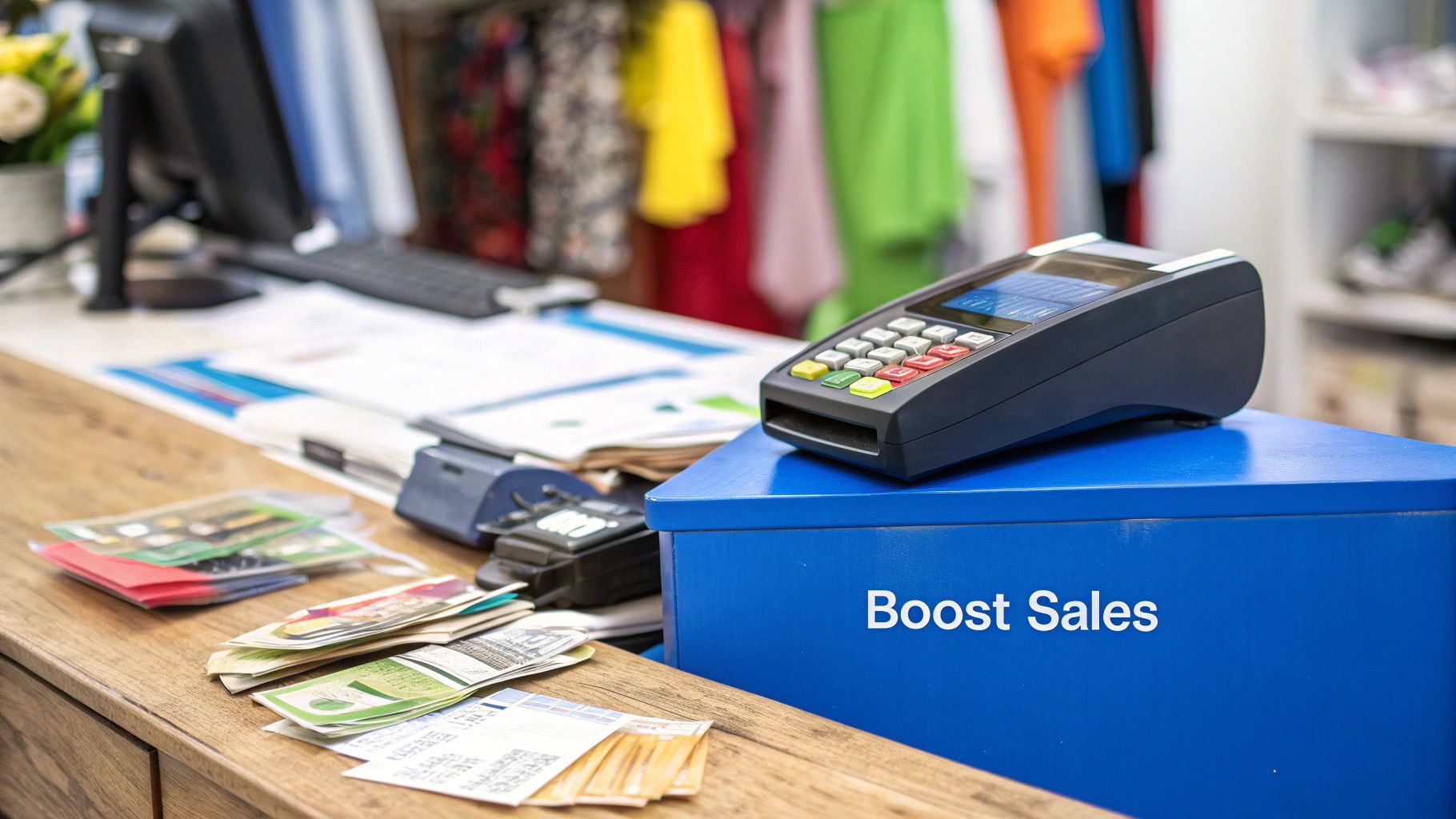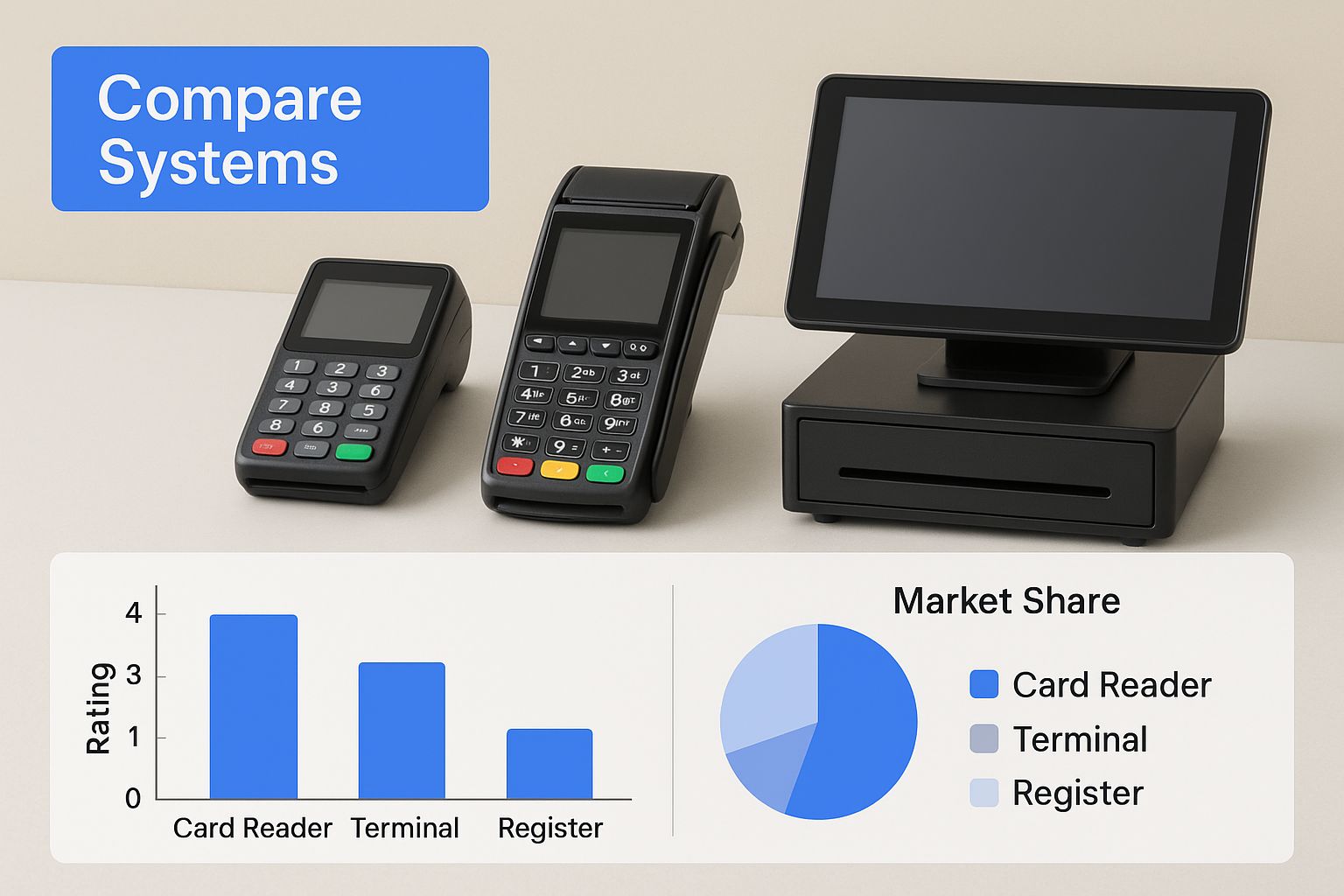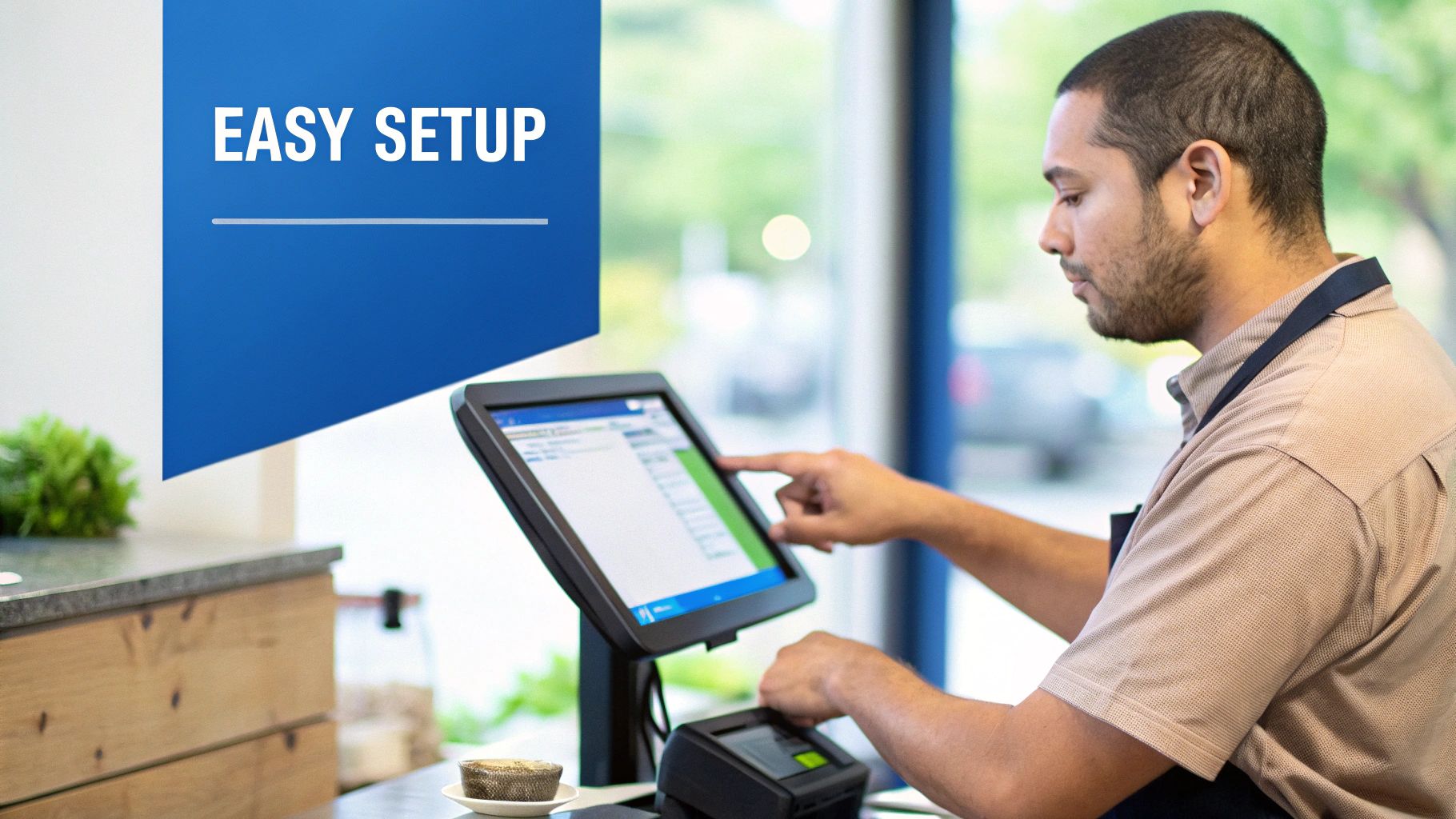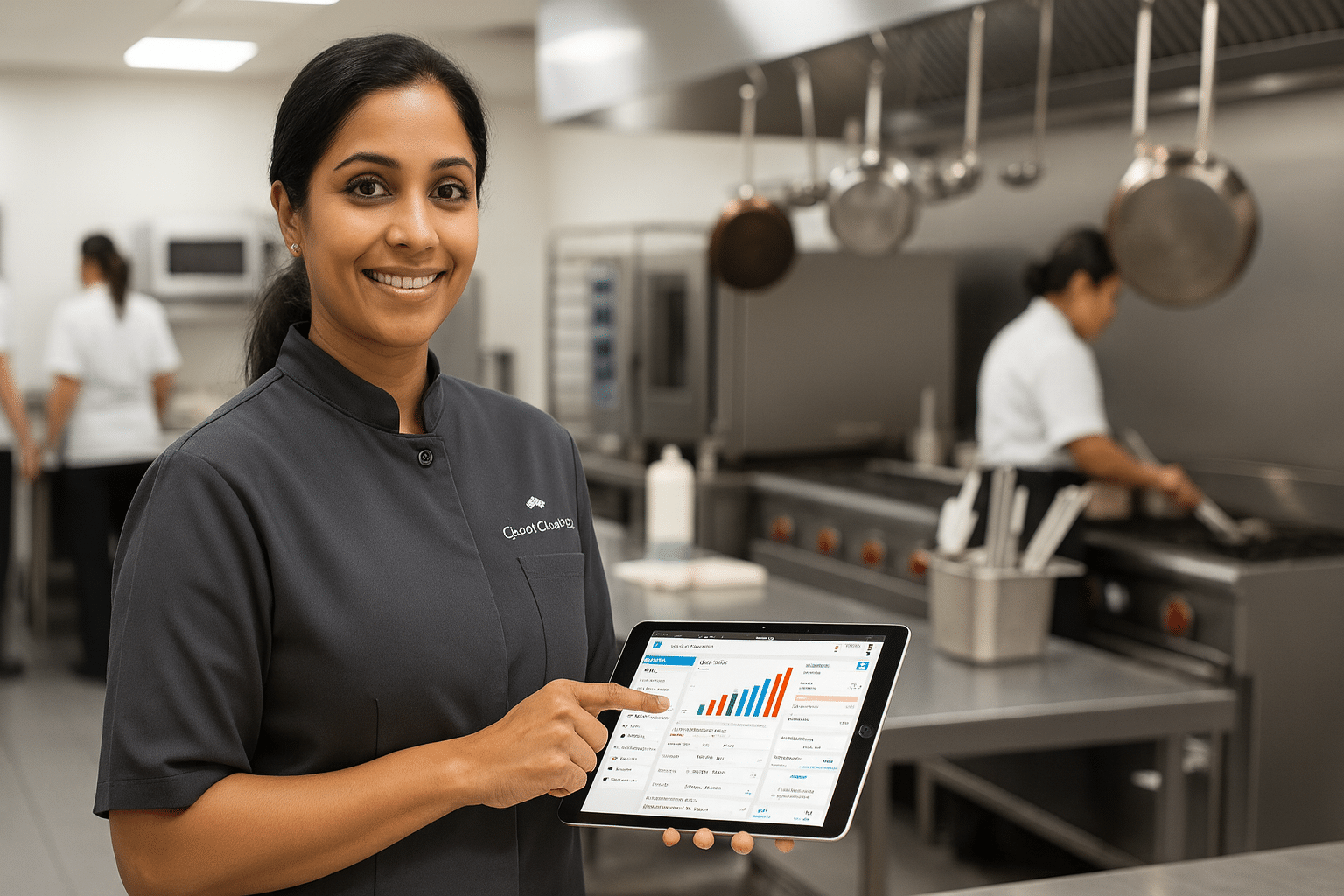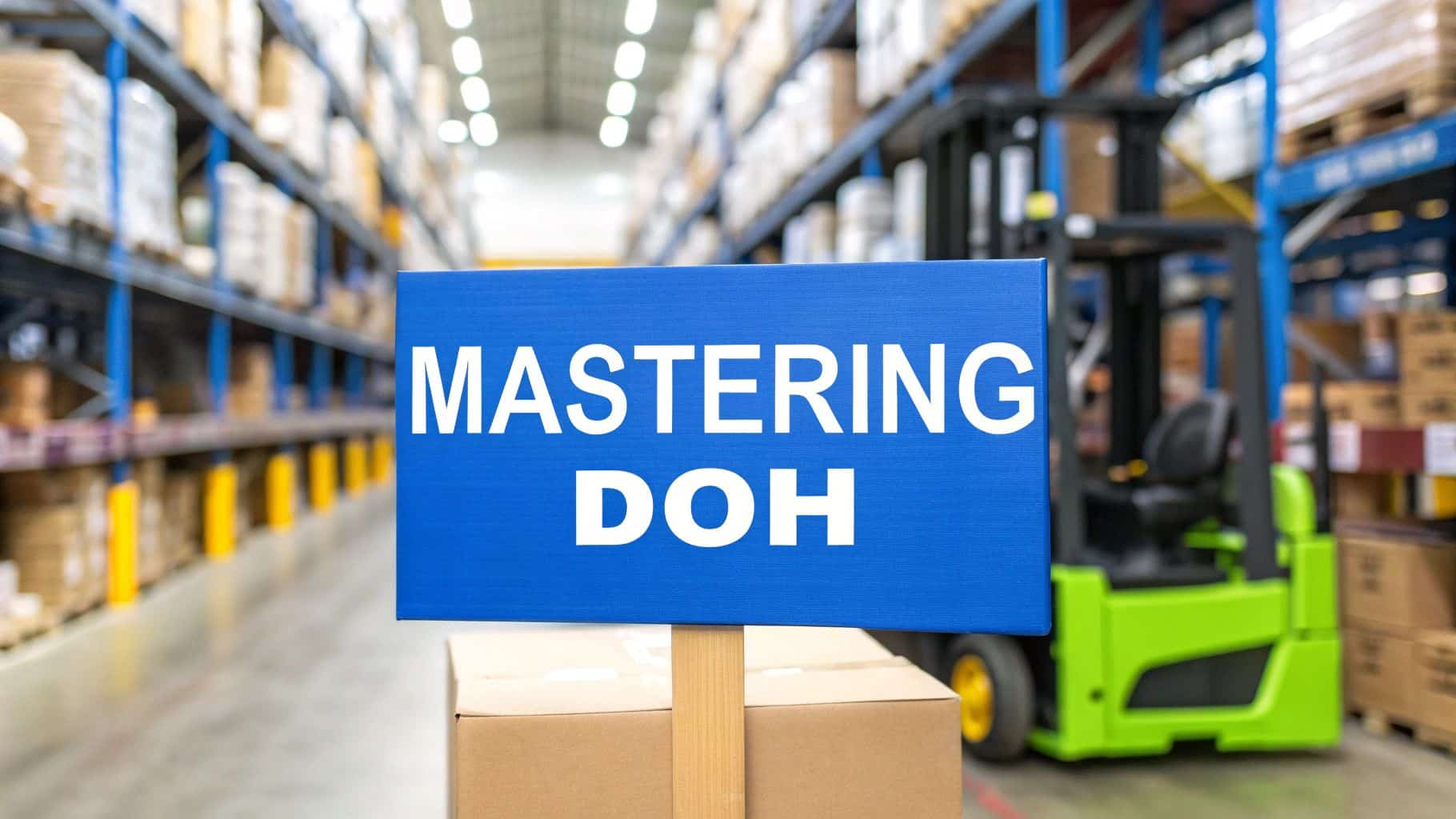Finding the right POS system for your small business usually means finding something that makes your life easier without costing a fortune. For a lot of entrepreneurs, a system like Biyo POS hits that sweet spot, blending serious inventory and sales power with a simple interface that just works. A good POS is so much more than a way to take money; it’s the command center for your entire operation.
How to Choose Your Small Business POS System
Picking a Point of Sale (POS) system is one of those big decisions you have to get right. It’s the operational core that juggles everything from ringing up sales and tracking stock to managing your customer relationships. Let's be honest, moving on from a basic cash register isn't really optional anymore—it's what you need to do to compete and use real data to grow your business. To make a smart choice, it helps to first understand what Point of Sale (POS) means in today’s retail world.
The market for these systems is blowing up. In 2024, the global POS terminal market hit a value of around USD 113.38 billion, and it's expected to climb to USD 123.15 billion by 2025. This isn't just big corporations; small businesses are a huge driver of this growth, with hardware alone making up over 62% of the market in 2024.
Key Considerations for Your Business
When you start comparing your options, the most important thing is how well a system fits your specific business. Are you a boutique that needs to track every last t-shirt, or a bustling cafe that needs to get orders to the kitchen in a split second? A one-size-fits-all solution just doesn't cut it. Getting a clear picture of what a retail POS system is can help you zero in on the features you’ll actually use.
A truly great POS doesn't just process payments. It gives you real, actionable insights—like your busiest hours, your best-selling items, and who your regulars are—turning simple sales data into a strategy for growth.
To make your search less overwhelming, it’s best to start with a few core criteria. This approach helps you cut through the marketing fluff and find a system that not only works for you today but can also grow with you tomorrow.
Quick Comparison of Top Small Business POS Systems
To give you a bird's-eye view, I’ve put together a quick comparison of the top contenders we’ll be looking at. This table lays out who each system is best for, its standout feature, and how it’s priced.
| POS System | Ideal For | Standout Feature | Pricing Structure |
|---|---|---|---|
| Biyo POS | Restaurants & Retail | All-in-one with offline mode | Tiered Monthly Subscription |
| Square | Startups & Mobile | Free entry plan & hardware | Flat-Rate Processing |
| Toast | Full-Service Restaurants | Restaurant-specific workflows | Subscription + Processing |
| Lightspeed | Complex Inventory Retail | Advanced inventory tools | Tiered Monthly Subscription |
This is just a starting point, of course. Now, let’s dive into what makes each of these systems tick and figure out which one might be the perfect partner for your business.
Essential POS Features That Drive Business Success
When you’re picking a POS system for your small business, it's easy to get lost in flashy promises. The key is to cut through the noise and focus on the core functions that will genuinely make your day-to-day life easier. A great POS isn't just a cash register; it's the command center for your entire operation, giving you the data you need to grow.
Let’s break down the features that really move the needle.
Advanced Inventory Management
For any shop or restaurant, mastering inventory is everything. A top-tier POS system takes the guesswork out of stock management, moving far beyond manual counts. With every sale, it updates your inventory in real-time, which means you'll never have to tell a customer, "Sorry, we're actually out of that."
This is also how you spot what’s hot and what’s not. See a particular coffee blend flying off the shelves twice as fast as the others? You can adjust your next order to keep up with demand and stop leaving money on the table. Systems like Biyo POS even send you low-stock alerts, so you’re never caught off guard when your bestsellers are running low.
The right inventory tools don’t just track what you have; they predict what you'll need. This proactive approach turns your stockroom from a cost center into a strategic asset, minimizing waste and maximizing profit.
Good inventory tools also let you manage variations with ease. Think different sizes and colors for a T-shirt, or extra shots and syrup choices for a latte. That kind of detailed tracking keeps everything accurate, from the front counter to the back room, giving you a true picture of your business's health.
Sales Analytics and Reporting
Data is gold for a small business, but only if you can actually use it. The best POS systems don't just collect transaction data—they turn it into simple reports and dashboards that you can understand at a glance.
Imagine knowing your busiest hours of the day without having to guess. That insight alone helps you build smarter staff schedules, ensuring you have enough help during the rush without paying people to stand around during quiet periods. You can also quickly see which menu items bring in the most profit, helping you fine-tune your offerings.
A well-designed dashboard, like the one in Biyo POS, visualizes all your key numbers so the important trends jump right out at you. You shouldn't need a degree in data science to make smart decisions for your business, and with the right reporting, you don't.
Integrated Payment Processing
A smooth and secure checkout is non-negotiable. An integrated payment system is a must-have, as it combines your payment terminal with all your sales and inventory data. This means no more clunky, separate devices and no more painful end-of-day reconciliations. Everything just works together.
Today's customers expect flexibility in how they pay, so your system needs to handle it all:
- Contactless Payments: Simple tap-to-pay with cards or mobile wallets like Apple Pay and Google Pay.
- EMV Chip Cards: The security standard for in-person card payments.
- Traditional Swipe Cards: Still important for customers who haven't made the switch.
You also need to get familiar with transaction fees, whether they're flat-rate, interchange-plus, or tiered. A transparent system protects you from hidden charges that slowly chip away at your profits. Remember, the hardware matters, too—sturdy credit card POS terminal stands create a professional and seamless experience for every customer at the counter.
Comparing the Top POS Systems Head-to-Head
Picking the right POS system isn’t about ticking boxes on a feature list; it's about understanding how a system actually performs when things get busy. A POS that’s a rockstar in a bustling cafe might be a terrible fit for a retail boutique with a ton of inventory. To get a real sense of what works, let’s put the top contenders into the specific situations they were built for.
This image gives you a quick visual rundown of how different POS systems are set up, so you can start to picture the hardware you might need.
As you can see, the setups range from sleek, all-in-one terminals to more flexible arrangements using tablets you might already own.
Scenario One: Retail Boutique Inventory Management
For any retail shop, inventory is everything. This is especially true if you're selling clothes or other items with lots of variations. The line between a good POS and a great one often comes down to how it handles product variants, purchase orders, and stock takes.
When it comes to deep inventory, Lightspeed Retail is a true powerhouse. It was designed from the ground up for retailers with complex needs. Its matrix system for handling variants—think size, color, and style—is genuinely best-in-class, letting you track every unique combination without a headache. It even has purchase ordering baked right in, so you can restock from suppliers without ever leaving the system.
On the other hand, Biyo POS offers a potent, intuitive alternative for small business owners who need real power without the steep learning curve. The variant management is clean and simple to master, and the low-stock alerts are a lifesaver, helping you prevent lost sales on your most popular products. While Lightspeed goes deep on complexity, Biyo zeroes in on the essential tools a small boutique owner actually uses every single day.
Of course, there’s also Square for Retail, which gives you solid inventory tools in both its free and paid versions. It’s a fantastic starting point, but it can feel a bit restrictive once your business grows and you’re juggling a large number of SKUs or a complex product catalog. Its main strength is its sheer simplicity and how easy it is for a brand-new business to get going.
Scenario Two: Cafe and Quick-Service Workflows
In a fast-moving cafe or quick-service spot, it's all about speed and accuracy. Your POS has to make the entire process, from taking an order to swiping a card, as smooth as possible. Anything less keeps the line long and customers waiting.
This is where Toast really owns the conversation. It's the industry standard for restaurants for good reason. Its entire workflow is built for food service, with built-in features like customizable modifiers for drink orders (extra shot, almond milk), perfect integration with kitchen display systems (KDS), and slick tableside ordering with handheld devices. It’s a heavy-duty system made for high-volume chaos.
Biyo POS makes a strong case for itself here with its incredible versatility and a dedicated quick-service mode. The interface is exceptionally clean and fast, letting your staff fly through orders with just a few taps. It handles complex order customizations without a problem and works great with kitchen printers and displays. Most importantly, Biyo's system is designed for lightning-fast training—a huge plus for any business that deals with high staff turnover.
Biyo POS’s offline mode is a game-changer for cafes. An internet outage can bring a cloud-only system like Square to a grinding halt, but Biyo keeps on processing payments and queuing transactions securely. This means you never miss a single sale during the morning coffee rush, a critical feature that provides some serious peace of mind.
Square for Restaurants is a very capable choice, especially for smaller cafes. The interface is a breeze to use, and setup is quick. That said, it just doesn't have some of the deeper, restaurant-specific tools you'll find in Toast or the ironclad offline reliability that Biyo offers.
Navigating Market Players and Vendor Lock-In
The POS industry has seen a lot of consolidation lately. The five biggest providers now control about 60% of the market share, which is something every small business owner should be aware of. This kind of dominance brings up real concerns about vendor lock-in, an issue that affects roughly 50% of businesses.
This has led to a 14% jump in the adoption of open-source POS software as owners look for more flexibility. Businesses that do find the right integrated POS system can see up to a 20% improvement in their cross-channel visibility, which makes a huge difference in operational efficiency. Keeping these dynamics in mind will help you make a smarter choice. You can find more great insights on POS industry trends at coinlaw.io.
Feature Deep Dive Biyo POS vs The Competition
To really crystallize the differences, it helps to put these systems side-by-side and look at the features that matter most to small businesses day in and day out.
| Feature | Biyo POS | Competitor A (Toast) | Competitor B (Square) | Key Takeaway |
|---|---|---|---|---|
| Offline Mode | Full functionality, including payment processing and transaction syncing. | Limited functionality; some features may not work without internet. | Basic offline mode; queues credit card payments but limits other functions. | Biyo provides the most robust offline capabilities, ensuring business continuity. |
| Hardware Flexibility | Works on multiple OS (iOS, Android, Windows) with your own devices. | Primarily uses proprietary Toast-branded hardware. | Offers a wide range of proprietary hardware but is largely a closed ecosystem. | Biyo offers the most freedom, potentially lowering upfront hardware costs. |
| Customer Support | Dedicated account managers and live support for all plans. | 24/7 support, but responsiveness can vary by plan. | Support is available but accessing live agents can be difficult on free plans. | Biyo's personalized support is a significant advantage for small business owners. |
| Ease of Use | Highly intuitive interface designed for minimal staff training. | Feature-rich but has a steeper learning curve due to its complexity. | Very easy to use, making it ideal for beginners and simple operations. | Biyo strikes a balance between powerful features and a user-friendly design. |
At the end of the day, the best POS system for your small business is the one that fits your unique workflow like a glove. By looking at how these top players perform in real-world scenarios, you can see past the marketing hype and get a clear picture of how each one would actually work for you.
Decoding POS System Pricing and Long-Term Value
The sticker price of a POS system is just the tip of the iceberg. To really figure out the best fit for your small business, you have to look past the monthly fee and see the whole financial picture. It’s the hidden fees, surprise hardware costs, and confusing processing rates that can turn a seemingly "affordable" POS into a serious budget-buster.
Without a transparent breakdown of every potential expense, you’re flying blind. It's not just about the software; it's about the entire ecosystem you’re buying into.
Beyond the Monthly Software Fee
That monthly subscription fee is always the most obvious cost, and it usually comes in different tiers. A basic plan might look like a great deal at first, but you'll often find it's missing essentials like in-depth reporting or the ability to manage a second location. Before you know it, you're forced into an expensive upgrade.
On top of that, many providers will nickel-and-dime you for add-ons that should really be part of the core package. Things like:
- Loyalty Programs: The tools you need to create customer rewards and sell gift cards.
- Advanced Analytics: Deeper reporting to actually understand sales trends and forecast inventory needs.
- Online Ordering Modules: The integration required to take orders directly from your website.
These "optional" features can pile up fast, so it’s critical to know exactly what you can't live without before you sign on the dotted line.
The Tangible Costs of Hardware
Hardware is a big one-time investment. While some systems are flexible and let you use your own iPad or computer, many push you into buying their proprietary terminals, printers, and scanners. This hardware lock-in can make it a real pain—and a real expense—to switch providers down the road.
The real cost isn't just buying the hardware; it's about its reliability and compatibility over the long haul. A system like Biyo POS, which runs smoothly on iOS, Android, and Windows, gives you the freedom to use your own devices. That choice alone can save you hundreds, if not thousands, in setup costs right out of the gate.
Always make sure to ask about hardware warranties, what happens if something breaks, and if they offer any financing to ease that initial financial hit.
Understanding Payment Processing Fees
Here’s where things get complicated—and often, expensive. Payment processing fees are what you pay on every single credit or debit card transaction. You'll typically run into three different pricing models, and knowing how they work is absolutely essential.
- Flat-Rate Pricing: This is the simplest to understand. You pay one fixed percentage plus a small per-transaction fee (e.g., 2.6% + 10¢). It's predictable, which is why it's so popular with new businesses.
- Tiered Pricing: This model is murky. It lumps transactions into different "tiers," each with its own rate. The problem is that it’s often unclear which tier a transaction will fall into, and you can bet most end up in the more expensive ones.
- Interchange-Plus Pricing: This is by far the most transparent model. You pay the direct wholesale "interchange" rate set by Visa or Mastercard, plus a small, fixed markup for your processor. While the rates can vary slightly, this model almost always results in the lowest overall cost for businesses doing consistent volume.
Trying to sort through these options is a lot, but picking the right one can save you thousands of dollars a year. For a deeper dive, check out our guide on decoding restaurant POS system costs, which has great insights for any small business. Partnering with a provider like Biyo POS that offers clear, straightforward processing takes the guesswork out of the equation and ensures you’re not getting taken for a ride.
How Biyo POS Is Built for Small Business Growth
After looking at features and pricing, it’s pretty obvious that not all POS systems are built the same—especially when it comes to the messy, exciting journey of a small business. The best POS isn't just a cash register; it's a partner in your growth. This is where Biyo POS really sets itself apart, offering a solution designed for today's sales and tomorrow's ambitions.
Biyo POS was built from the ground up to solve the real-world problems entrepreneurs run into every single day. The whole idea is to make powerful tech genuinely accessible, so you can spend less time fighting with your software and more time with your customers.
Intuitive Design That Accelerates Operations
Let's be honest, staff training is a huge headache for any small business. High turnover and seasonal rushes mean you need a system that a new hire can pick up in minutes, not days. Biyo’s interface is exceptionally clean and intuitive, which drastically cuts down that learning curve.
Picture a busy coffee shop during the morning rush. A new barista can step up to a Biyo terminal and start confidently punching in complicated orders with custom modifiers after just a quick walkthrough. That simplicity is a massive strategic advantage. It minimizes mistakes and keeps the line moving, which has a direct impact on customer happiness and your bottom line.
A POS system should empower your team, not intimidate them. Biyo’s user-centric design means your staff can focus on creating a great customer experience instead of getting bogged down by complicated software. This operational efficiency is a cornerstone of sustainable growth.
This focus on ease of use doesn't stop at the front counter. Business owners can quickly pull daily sales reports, tweak menu items, or check inventory levels without needing a degree in computer science. This puts critical business data right at your fingertips, helping you make smarter decisions, faster.
Real-World Scenarios Where Biyo Excels
The true test of a POS system is how it performs in the wild—in the everyday situations that can make or break a small business. These scenarios show how Biyo's features are built for proactive management, not just reactive record-keeping.
-
For the Retail Boutique: The owner gets an automated low-stock alert for a popular handbag. Before the last one even sells, they can fire off a new purchase order directly through the system. This prevents a stockout and ensures they capture every possible sale during a peak shopping weekend.
-
For the Neighborhood Cafe: The manager checks the "Items by Profit" report and sees their specialty cold brew has the highest margin. Armed with this insight, they create a "combo deal" promotion and strategically feature it on the KDS to upsell customers and give overall profitability a nice boost.
These examples aren't just hypotheticals; they show how Biyo acts as a proactive business assistant. It’s not just telling you what happened; it’s giving you the tools and data you need to shape what happens next. This is a crucial difference from systems that just process payments. You can see a detailed breakdown of how Biyo's forward-thinking approach compares to older systems in our analysis on why Biyo is becoming a popular choice over Clover.
Unwavering Reliability and Dedicated Support
For a small business, downtime simply isn't an option. An internet outage can bring your entire operation to a screeching halt, leading to lost sales and unhappy customers. Biyo POS tackles this head-on with robust offline capabilities, so you can keep ringing up sales and taking credit card payments even when your connection goes down.
That kind of reliability brings incredible peace of mind. While other systems become expensive paperweights, your business keeps running smoothly. Every sale is captured and the data automatically syncs up the moment you're back online. That feature alone makes it a better choice for any business that can't afford interruptions.
Biyo also gets that small business owners wear a lot of hats and need support they can actually count on. The global POS software market is absolutely exploding, projected to jump from USD 21.1 billion in 2023 to USD 74.7 billion by 2032. As more businesses adopt these tools, quality support becomes non-negotiable. Biyo provides expert guidance from a team that understands these pressures, helping you get the most out of your system to drive your business forward.
Your Top Questions About Small Business POS Systems, Answered
Picking the right POS system for your small business always brings up a lot of questions. Before you make a final call, you need to be sure the system can handle the real-world, day-to-day challenges you'll face. I've put together some answers to the most common concerns I hear from business owners to help you feel confident in your choice.
Let's dive into some of the big ones, from dreaded internet outages to the nitty-gritty of hardware and returns.
What Happens If My Internet Goes Down?
For any business running on a cloud-based system, an internet outage is a major fear. A lost connection can quickly lead to lost sales and unhappy customers. That’s precisely why a POS with a solid offline mode isn't just a nice-to-have feature; it's essential.
When your internet connection drops, a system with a well-designed offline mode, like Biyo POS, keeps things running smoothly. It securely saves credit and debit card transactions in a queue, so you can continue serving customers without missing a beat. As soon as you're back online, the system automatically syncs all that stored transaction data, bringing your sales records and inventory counts up to date.
A POS without a reliable offline mode is a huge risk. If it can't process payments when the internet is out, it becomes a liability. This feature should be at the very top of your checklist.
How Does a Modern POS Handle Returns and Exchanges?
Forget the manual headaches of old-school cash registers. Modern POS systems make returns and exchanges incredibly simple. The entire process is handled right in the software, which is a better experience for your staff and your customers.
When a customer needs to make a return, your team can pull up the original transaction in a few seconds. They can usually search by:
- The customer's name
- The credit card used
- The receipt number
Once they find the sale, the system walks them through the refund process. It automatically adjusts your inventory levels and sales data in real-time, so your numbers are always accurate. Exchanges are just as easy—the POS can credit the returned item and ring up the new one in a single, seamless transaction.
Do I Need Industry-Specific POS Hardware?
This really depends on your specific business. Some POS providers try to lock you into their expensive, proprietary hardware, but thankfully, many modern systems give you much more freedom.
If you run a small retail boutique or a simple coffee shop, you can often get by with just an iPad or an Android tablet and a card reader. It's a great way to keep your initial costs low. On the other hand, a busy restaurant will get a ton of value from specialized equipment like kitchen display systems (KDS), rugged countertop terminals, and handheld devices for taking orders at the table.
The key is finding a POS that works with a wide range of hardware. A system like Biyo POS is hardware-agnostic, running smoothly on iOS, Android, and Windows devices. This flexibility means you can start with hardware you might already have and add more specialized gear as your business grows. You stay in complete control of your investment.
Ready to see how a flexible, reliable, and intuitive POS can change the way you run your business? Biyo POS is built to handle the real-world challenges small business owners face every day. Discover the Biyo POS difference and start your free trial today!

